Introduction
The research paper will focus on Geo science and the environmental flows that are found in the Murry Darling River in Australia which covers an area of 1.06 million kilometres per square metre. The economic output that is generated from the Murry Darling River is approximately $23 billion in Australian dollars.
From this amount, $10 billion has been set aside to be used for agricultural purposes. While the use of the Murray River’s resources has been beneficial to the Australian Government, there have been notable ecological and environmental degradation of the river’s resources as a result of pollution and misuse of the river basin.
To deal with the environmental problems facing the Murry River, the Living Murray Initiative was initiated to restore the basin to a clean water resource. The initiative involved conducting scientific investigations and analysis by focusing on the increased environmental flows to the river and the benefits that would be derived by recovering the water basin of the river.
The composition of the river basin was analysed using scientific methods and the soil, vegetation and plant species were also examined to determine the extent of the degradation in the basin.
The use of science in the initiative therefore played a major role in developing a strategic plan that would be used to manage and coordinate the sustainable use of the river’s water resources as well as other environmental resources in the Murray Darling River Basin.
The incorporation of Geo science in the Murry Initiative highlighted the importance of using scientific methods in conducting environmental management techniques to prevent the effects of degradation to the environment. To further understand the concept of Geo Science, a definition is in order.
Geo science, which is also referred to as Earth Sciences, deals with all scientific aspects that are related to the composition of the Earth. Geo science involves the study of the atmosphere, air particles, soil composition, water, plant and vegetation and the biosphere.
Incorporating Geo Science into the environmental management activities has ensured that the proper strategies and techniques have been used to deal with the ecological issues that arise as a result of environmental degradation.
The analysis of the affected natural resources by using geo scientific approaches such as geological engineering, hydro ecology, and ecosystem response models have ensured that appropriate measures are designed to deal with these issues. There are however gaps that have arisen in the use of Geo science and science in managing the environment.
These gaps have arisen because of the limited amount of research information that is available on the subject. The studies conducted on geo science and environmental management have been limited with many researchers mostly choosing to focus on the concept of environmental geology which shows the interaction that human beings have with the environment and the impact this relationship has on the ecological system on the environment.
The limited research therefore makes it difficult to gain any further knowledge in relation to the use of geo science in environmental management activities.
The Murray Darling Basin
The river basin is viewed to be the lifeline of the eastern parts of Australia which is made up of Victoria, Queensland and New South Wales. The basin is made up of five river systems which are the Darling River, the Murray River, Murrumbidgee River, Billabong Creek, and the Lachlan River.
The Murray Darling Basin is mostly used for 40 percent of the irrigation purposes in the agricultural fields that are based in these three regions. The diagram below represents the size and topography of the Murray Darling River Basin and the various river systems that are found in Queensland, Victoria and NSW as identified by Prasad and Khan
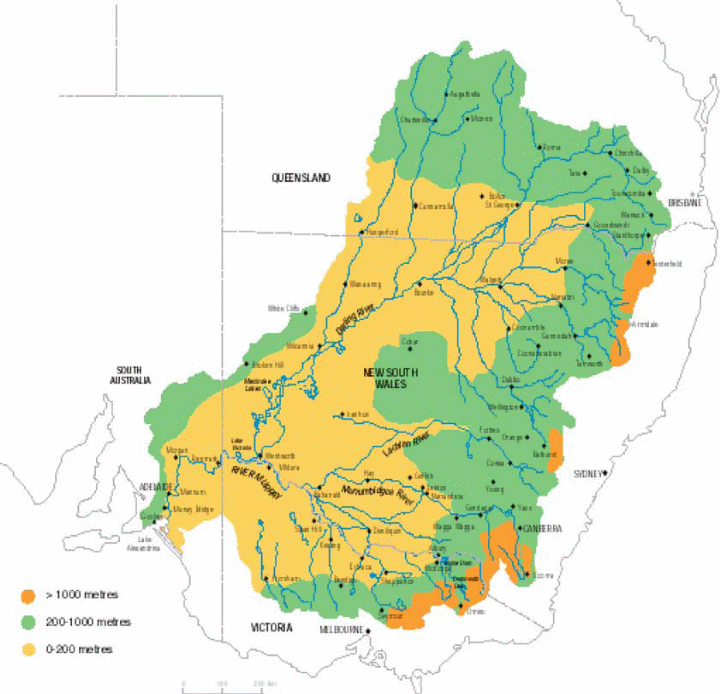
The most valuable resource of the Murray Darling region is the water that is found in the river which not only sustains the agricultural industry in Australia but also provides a home for the marine wildlife and the plant species that are located around the river basin.
According to Ortega, the number of endangered bird species found in the Murray River total 35 while the number of endangered animal species amounts to 16. The river also boasts of having 35 different marine species in the various river systems that make up the Murray Darling Basin.
The river basin is also known to host one of the richest indigenous archaeological sites in Australia that have prehistoric features such as old camp sites, burial grounds, canoe shaped trees and scarred trees. Despite having all these many features, the river has faced degradation as a result of development activities by the Europeans in a span of 50 years that have seen the basin’s resources deteriorate.
Problems in the Murray Darling River Basin
The problem of land degradation and salinity became more prominent in the 1960s after the River Murray Commission conducted a study on the salinity levels in the water resources of the river.
The results of the study showed that 40 percent of the river’s length had lost a significant amount of its marine wildlife and plant species as a result of the high salinity in the water. The results also showed that 10 percent of the Murray River’s length was impaired which saw the loss of 50 percent of the aquatic macro invertebrates that were expected to occur there.
The high salinity levels have continued to threaten the native plant and marine species that live within the river basin. The salinity levels in the basin accounts for half of Australia’s saline seepage levels which are mostly caused by high irrigation, increased land developments, and erection of structures along the river.
The global climatic weather conditions that keep changing and are erratic have also had an impact on the water levels of the Murray River. The weather changes have led to increased drought and flooding situations that have affected the composition of the river and its five systems.
Apart from increased saline levels, the other forms of land degradation that have affected the Murray include water logging and high acidification of the water.
The extensive land degradation that has taken place in the Murray flood plains and the major deforestation experienced in the three regions has led to a decrease of vegetation along the river channel. The introduction of exotic tree species such as the willows and poplars has continued to degrade the river basin even further as these trees require more water to grow.
Environmental Flows in the Murray Darling River
Environmental flows are described as the releases of water by water catchment areas such as the Murray Darling River to the surrounding environs of the water areas. Environmental flows which can also be the natural flow regimes of a river are viewed to play an important part in forming the ecological features and wetlands of other river systems that form part of the river basin such as the Murray Darling.
The environmental flows of a river are influenced by the shape and size of the river basin, the distribution of the marine habitat and plant species, the structure of the marine habitat and the nature of the relationship between the main river channel and the flood plains.
The Murray Darling River is mostly characterised with unpredictable flows with the high flows occurring during the summer and spring seasons of Australia while the low flows occurred during the winter and autumn seasons. The flows became more unpredictable with the increasing amount of development that was taking place near the river basin and the five river systems.
The development of structures such as houses and commercial buildings also saw the need to supply water to these structures which was especially high during the autumn and summer seasons.
The water quality of the Murray has also been affected by the constant water shortages that arise due to increased consumption activities such as irrigation and water supply activities as well as the severe droughts that have continued to affect most parts of Australia.
The table and graph below represents the biotic, monthly environmental flows and environmental condition of the Murray Basin as outlined by the Murray Darling Basin Commission.
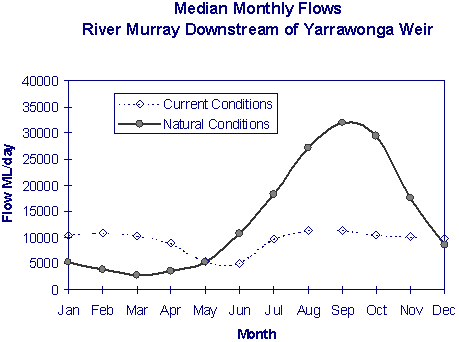
Murray Darling Basin (2009).
Reforms taken to reduce the Degradation of the Murray River
The formation of the Murray Darling Basin Commission (MDBC) by the Australian Government was meant to steer major reforms on the river basin that would see the effects of the land degradation being reversed as well as an improvement in the management of water resources.
The commission initiated a combination of hydrological and salinity abatement projects that would be used to deal with acid and saline levels in the river basin.
The initiation of these projects on the Darling River saw a reduction of 20 percent of the average salinity levels in the river systems that were based in the Southern Part of Australia. To recover the lost plant and marine wildlife species that were present in the river before the degradation, the use of fish ladders and weirs around the dams were introduced.
The MDBC has so far spent over 650 million AUD to increase the amount of environmental flows into the river. This amount of money has mostly been used to address the issue of large scale irrigation activities that are taking place in the three regions that encompass the Murray Basin.
Some of the projects that have been initiated to deal with irrigation have been water trade programs within the three states of Victoria, NSW and Queensland. The conservation of water has also been used to change the hydrological flow of the water with particular focus on the environmental flows in the headwater dams.
Environmental Management of the Murray-Darling Basin
The environmental management of the Murray Darling Basin has been viewed to be a complex process because of the complexity of the river system and the various features that make up the Murray Darling Basin.
The various environmental issues that are affecting the basin and the extensive degradation that has taken place in the surrounding areas has become a source of concern for the relevant authorities charged with the conservation of the river.
The MDBC which has the main authority for performing conservation and management activities has developed a Basin Cap that will be used to limit the amount of water diverted for consumption purposes.
The cap was also developed to deal with issues such as the poor water quality in the Murray River which has been as a result of the degradation that has taken place in the river. The high acidification and salinity in the water has led to the loss of indigenous plant species as well as indigenous marine wildlife.
The health of the river is projected to become worse if current management systems that are in place are not changed to deal with the situations. The large amounts of water that are being used for irrigation purposes have led to a reduction in the water levels of the river as a result of poor irrigation management practices.
The benefits of the MDBC Basic Cap have seen the stabilisation of rights to access the river for consumption purposes by the existing users. There has also been an increased emphasis on achieving water use efficiency for developmental purposes.
Another benefit of the Basic Cap has been a notable decrease in the percolation of the River’s groundwater leading to fewer cases of water logging and lower salinity levels in the water and the soil. The general water quality has also been improved as well as the natural ecosystems found within the river basin.
Science in Environmental Management
The use of science in environmental management activities has been viewed to be an important concept that has continued to gain more prominence in the recent past. Environmental science has been defined as the study of the physical aspects of the environment such as the air, water, soil, plant and animal habitats as well as human activities and their impact on the environment.
The scientifical aspect of environmental science analyzes the chemical and biological aspects of the environment such as the water bodies, micro organisms, soils, rocks and minerals.
The use of science in environmental management activities has enabled the use of scientific data and results to develop programs that will be used to protect the environment from further degradation and deterioration.
Environmental science looks at the relationships between the global, social and human systems that lead to the degradation of the environment and the deterioration of the natural resources found in the environment.
Scientific approaches are developed to deal with these issues by creating sustainable science programs for community and business use. Such programs will provide scientific information on what causes the deterioration of the environment and what steps can be used to control and prevent these problems from recurring again in the future.
Environmental Geoscience and the Murray-Darling Basin
The severe drought and water shortages that are experienced by the Murray Darling River Basin have dried out some of the wetlands that are located near the Murray River a situation that has seen the wetlands being exposed to sulfidic sediments that have increased the levels of acidification and salinity.
Environmental geoscience was conducted in these wetlands to determine the amount of acidification and sulfidic sediments that are formed when there is a reduction of sulphate in the water.
The main cases of acidification identified in the River basin are the sulfidic sediments such as acidic sulphate soils that are left behind when the river basin dries. The amount of sulfidic levels have continued to increase as a result of the changing natural wetting and drying cycles that have been caused by the severe droughts.
The three wetlands that are located along the Murray Darling River are the Psyche Bend Lagoon, the Tareena Billabong and the Bottle Bend Lagoon.
These three wetlands have continued to experience high acidification and salinity levels in the water which makes them prone to continuous flooding during the rainy season. Geoscience data shows that the most common sulphide mineral found in all the three wetlands to be iron monosulfide greigite which might have an adverse effect on the water resources and the nutrients found in the water.
The diagram below represents the various wetlands and river systems that make up the Murray Darling River Basin as represented by Prasad and Khan in their 2002 report on the water and climate of the Murray Darling River Basin
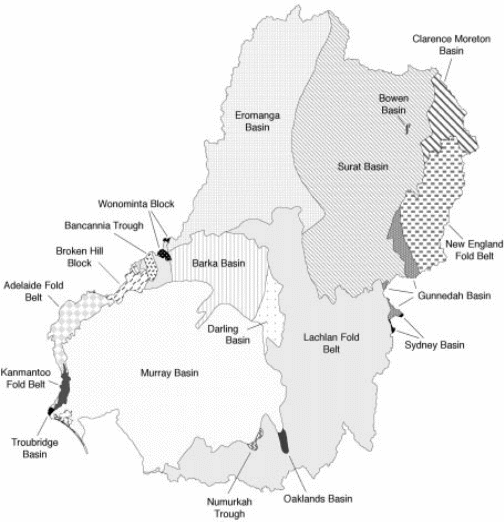
Prasad and Khan in their (2002)
The Distribution of Inland Wetlands in the Murray Darling Basin
The use of geoscience was used to examine the extent of the sulfidic sediments in the three wetlands. Geoscience data showed that 21 percent of the three wetlands examined had evidence of sulphur in the soil sediments that was of a high concentration. This in turn increased the acidification levels in the water and soil in the Murray Darling River Basin.
The highest concentration of sulfidic sediments was found in the lower areas of the Murray River. The geoscience data collected from analysing the wetlands also showed that there was a correlation between the sulfidic sediments in the wetlands and the concentration of sulphate in the overlying water columns of the river basin.
This high amount of sulphate concentration in the river’s water has been noted to be a cause of concern for most of the wetland managers in the area. There has been an increasing need to return the wetlands to their original form to ensure that the state of the river is healthy.
As long as the sulfidic sediments are present in the wetlands, the natural wetting and drying cycle will be unable to take place effectively. The wetting and drying phase should only be reinstated if the risks of acidification have been properly assessed.
Ecosystem Response Modelling in the Murray Darling Basin
The modelling of conservation activities has mostly been focused on the use of geoscience to provide guidelines and information that will be used for the water management of the Darling basin which is Australia’s largest and economic water catchment area.
The use of ecosystem response models has been viewed to be an important concept when responding to the declining ecological conditions in the Murray River Basin. The quantitative ecosystem models have been developed to ensure that there is better decision making with regards to the issue of water allocation and the deterioration of the Murray Basin.
One of the main response models that were proposed to be used in the environmental management of the Darling Basin was CART analysis which can be used to model thresholds that would represent the conditions of the flood plains and the wetlands.
Other response systems that incorporated the use of geoscience information and knowledge were the use of geographic information systems that had remote sensors that would be used to detect the extent of degradation in the plant and marine species found in the river basin.
An example of a remote sensing approach according to Saintilan and Overton is the Landsat archive technique which can be used to reconstruct the original form of the river by analyzing the historical frequency of the river’s degradation over the large wetland areas.
Decision support systems have also been seen as ecosystem response models because they incorporate the ecological and hydrological aspects in the development of the decision models that will be used to manage and conserve the water. Examples of decision support systems that have been used on the River Basin are the Murray Flow Assessment tools and the water allocation decision support system.
The use of these response models has ensured that there is proper management of the environmental flows of the Murray Basin and that there are developed plans that will be used to manage conservation activities. The diagram below demonstrates an example of a response modelling system that can be used to manage the Murray Darling River Basin.
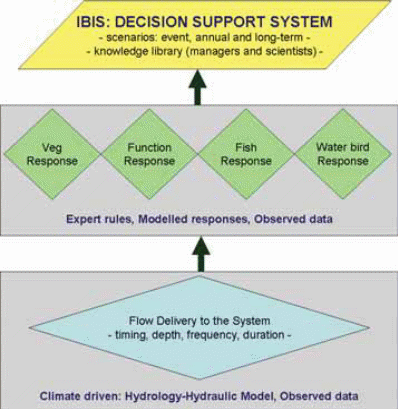
Saintilan and Overton (2010)
Geo science data on the Murray Darling Basin
The geoscience information that was collected focused mostly on the environmental impacts of the climate changes to the river basin. General circulation models were used to predict the amount of green house emissions in the atmosphere that would affect the composition of the river. Geo science information was used to predict the climate changes that would take place in Australia in 2030.
The predictions saw that there would be a rise in the average temperature from 0.4 to 2.0 degrees Celsius. The amount of rainfall and snow experienced during the winter season would also increase from -10% to +5% in 2030. The predicted changes that would take place in the river basin would be between +1% and -15%.
This would mean that the level of water in the basin will reduce drastically during the winter and spring season. The diagram below represents the changes in the amount of rainfall that have been predicted for the year 2030 based on Prasad and Khans 2002 synthesis report on climate in the Murray Darling Basin.
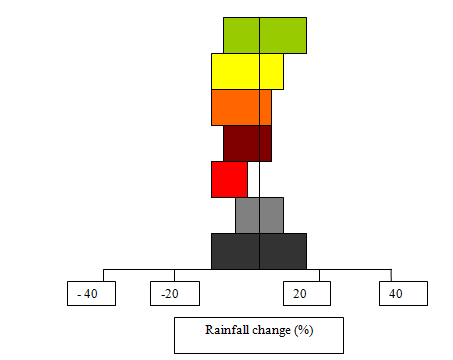
Prasad and Khan (2002)
The Macquarie catchment was used as a model to explain the effects of climate change on the availability of water in the area. This was the only study that was conducted in the whole of Australia. The integrated quantity quality model (IQQM) was developed to explain the changes in precipitation and evaporation in the Macquarie catchment.
The IQQM analysed the risks that were associated with a reduction in water levels in the catchment area. The results of the study showed that the allocation of the water for irrigation purposes would be below 50 percent of the required allotment. The other result of the study was that the wetland areas would experience a decrease in the number of rain days experienced in the region.
The use of Science in the Murray Darling Basin
River modelling software has been used by water managers to understand the effects of increased irrigation and land degradation on the Murray Basin. The modelling software incorporates the use of computer based programs that track the amount of water in the river basin which will help in the management of water supply for irrigation and consumption purposes.
The use of geoscience knowledge and basic scientific models has been used to develop these river models to ensure that water management activities taking place in the river are done effectively. Environmental geoscience has also been used to assess the floodplain ecology of the river and its riveline which is facing the lack of environmental flows.
Geoscience has been used to investigate the ecosystems within the flood plains and their functionality as well as the climate in the Murray River region. The impact of the changing climate has also been analysed by looking at how it will affect the future water resources of the river basin.
Groundwater research will also be conducted through the use of geoscience information and knowledge. This research will be used to manage the groundwater resources of the Murray Basin for the current and future durations.
The amount of geoscience data collected on groundwater research showed that there was a need to conduct numerical modelling for groundwater risk assessment activities and the setting of boundaries that would be used to plan for the management of the groundwater.
Geoscience knowledge was also necessary in evaluating the risks of groundwater such as the levels of salinity, acidification, base flow impacts and the ecological assets.
The Geospatial inundation patterns in the semi arid regions of the River Basin
The flood plain wetlands of the Murray Darling River are viewed to be the most ecologically significant components in the whole of Australia’s water areas in terms of the high abundance of aquatic and plant habitats located within the wetlands. The environmental flow of the river has been seen to be the main driver behind the sustenance of the river ecology and the inundation patterns of the floodplain wetlands.
Inundation has been identified as one of the major influencers of marine distribution, water composition and the survival of the plant species in the Murray basin. Understanding the geoscientific aspects of temporal and spatial variability in the inundation patterns is a critical step in managing the environmental flows of the Murray Darling River.
The use of satellite remote sensing such as the Landsat satellite has provided the opportunity to monitor the inundation patterns of the floodplain wetland areas. The patterns will be used to manage the ecosystem in the Murray Basin by mainly focusing on the vegetative species in the basin as well as the marine habitats.
Use of Geoscience in the restoration of significant wetlands in NSW
The significant wetlands in the Northern part of the Murray Darling basin have faced a constant decline over the past decade which has seen the mortality of wetland trees and the gradual reduction in the amount of wetland vegetation species.
To respond to the ecological issues that were affecting these critical wetlands in the Northern parts of the Murray Basin, the NSW government in a collaboration with the Victoria and Queensland state governments initiated the rivers environmental restoration program (RERP) that would incorporate the use of geoscientifc information and knowledge for environmental management purposes.
The scientific part of the RERP program was used to improve the hydrological representation of the wetlands in the northern parts of the river basin by the construction of hydrodynamic models and the conducting of soil surveys to determine the amount of degradation currently in the basin.
Geoscientifc knowledge has been used to develop models such as the LIDAR which have been used to formulate water management programs and prediction programs that will assess the frequencies and durations of flooding in the area. The use of hydrological models and ecosystem response models in the Murray area has been viewed to be important in managing the river water.
The effects of environmental flow on the growth of marine species
The northern part of the Murray Darling Basin has faced alterations in the timing and frequency of the flood events that are experienced in the region which has resulted in the decline of water levels and the general health of the river basin’s vegetation, marine species.
The efforts to manage the health of the basin have been hampered by the lack of proper understanding of the biology of the various freshwater marine species and how the environmental flow characteristics will impact the number of these fish species in the river basin.
The two fish species that were studied included the Retropinna semoni/ Australian Smelt and the Nematolosa erebi (bony bream).which are commonly found in the Gwydir wetlands of the Murray Darling River.
Conclusion
There has been limited research on the field of geoscience in environmental management because of the concept being fairly new. The review of geoscience literature and articles for research that can be used in the environmental management of the Murray Darling River Basin has shown that there is limited research conducted on the subject of geo science in environmental management programs.
The research used in this paper has however demonstrated that there is hope for future studies and research work in the topic as the scientific aspect of the topic is useful in developing and analysing environmental conservation and management activities.
Bibliography
Australian Water Resources, ‘River Condition in the Murray-Darling Basin 2001’, Australian Government, National Water Commission, 2005.
Bhat, A., ‘The politics of model maintenance: the Murray Darling and Brantas River Basins Compared,’ Water Alternatives, Vol.1, No.2, 2008, pp.201-218.
Department of the Environment and Heritage, ‘Integrated Water Resource Management in Australia: The Murray-Darling Basin Initiative,’ Australian Government, Department of Sustainability, Environment, Water, Population and Communities, 2004.
Hall, K. C. and Baldwin, D. S., ‘Distribution of inland wetlands with sulfidic sediments in the Murray Darling Basin, Australia,’ Science of the Total Environment, Vol.370, No.1, 2006, pp.235-244.
Heagney, E., Spencer, J., Fowler, A., and Allman, R. ‘The effect of flow on the growth and conditions of two native fish species Gwydir wetlands’ University of NSW, Sydney, 2010.
Murray Darling Basin, ‘Environmental Flows and Water Quality for the River Murray’ 2009. Web.
Newage Publishers, ‘ Environmental Science’, 2010. Web.
Ortega, V., ‘Australia’ search for another food bowl’, 2010. Web.
Prasad, A., and Khan, S., ‘Murray-Darling Basin dialogue on water and climate,’ River symposium, Brisbane, 2002.
Saintilan, N., and Hillan, J., ‘Progress towards the restoration of significant wetlands in NSW under the Rivers Environmental Restoration Program,’ Rivers and Wetlands Unit, NSW Department of Environmental Climate Change. 2010.
Saintilan, N., and Overton, I., ‘Ecosystem response modeling in the Murray Darling Basin,’ Csiro Publishing, Victoria, Australia, 2010, Pp. 412-415.
Simpson, C. (Ed.) GEM NEWS: Newsletter of the IUGS commission on Geoscience for environmental Management. 2007, pp 1-28.
Thomas, R., Lu, Y., Cox, S. and Hunter, S., ‘Spatial inundation patterns in floodplains wetland of semi-arid regions in the Murray-Darling Basin,’ University of New South Wales, Sydney, Australia, 2010.
UNEP, ‘Environmental Flows: The living Murray Initiative, Australia. Report for the Global Ministerial Environment Forum, Jeju, Korea. 2004, p.2.
Webb, J., ‘Inland acid Sulphate soils: a study of three wetlands along the Murray- Darling River.’ Environmental Geoscience, 2009. Web.
Young, B., ‘Science supporting water management in the Murray Darling Basin’ CSIRO, 2010. Web.